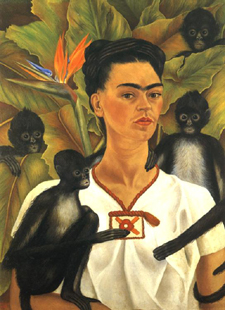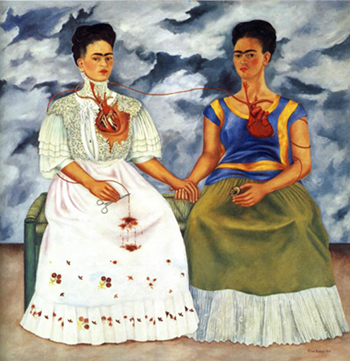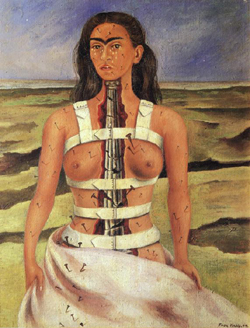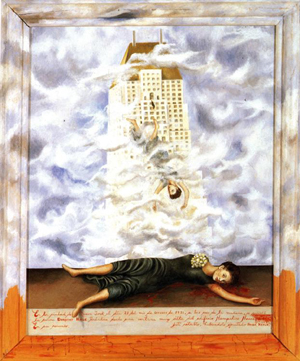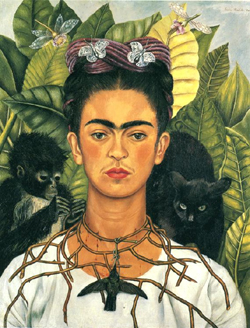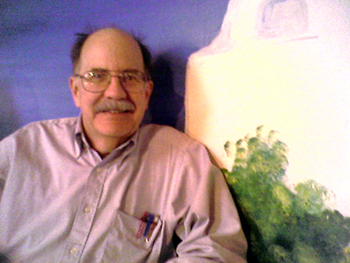Musings
an Online Journal of Sorts
By Alyce Wilson
May 8, 2008 - Self-Portrait with Tambourine
 The
big, shocking result on American
Idol last night was that there was no big, shocking result.
The
big, shocking result on American
Idol last night was that there was no big, shocking result.
Many times before at this stage in the season, a popular finalist has been sent home because viewers assumed he or she was safe. This happened to Tamyra Gray and also to Chris Daughtry. Some critics had feared a similar oversight would endanger the two Davids, Archuleta and Cook, who are considered the front-runners.
Host Ryan Seacrest probably helped to fend off such an event by reminding viewers of what happened in previous years and urging them to vote for their favorites, no matter how safe they believed them to be.
So instead of the Davids, Syesha Mercado and Jason Castro appeared in the bottom two. Syesha has been improving throughout the weeks but has been in the bottom two before, so if she'd been cut, it would have been a lesser shock. However, Jason Castro, who fell apart on stage this week, forgetting the words to "Mr. Tambourine Man," was sent home instead.
When Ryan observed that he seemed relieved, Jason admitted he was. He said they had to perform three songs next week, and he didn't know what he would have done. Good luck with the summer tour, then! That's where the top 10 finalists perform all over the United States, and he'll have to learn a lot more than two songs, plus choreography to boot.
Clearly, the novelty of appearing on the show had worn off for Jason, who barely seemed to be trying in recent weeks. He showed potential at the beginning of the season but failed to improve or grow. While he's got a pleasant personality and a pleasant voice, I think he's already decided that a career in the music industry isn't for him.
More on American Idol:
Musings on American Idol Season 7
Sunday was my Dad's last day in town, and he met The Gryphon and I at our place around noon. We drove in my car to The Philadelphia Museum of Art, where we had tickets for the special Frida Kahlo exhibit, celebrating the 100th anniversary of the artist's birth.
As often seems to be the case, we were surprised to discover an event taking place near the museum. It involved a number of tents in front of the museum, plus lots more people and traffic. What's more, the police were redirecting traffic to free up the circle in front of the museum, probably for the event. We tried to park in the lot by the flower gardens behind the museum, but it was full so we drove several blocks away, parked in a residential neighborhood and walked back.
The line for the exhibit was long, but I'd seen it that long before. I think the exhibit, overall, was organized better than the Salvador Dali exhibit of several years ago, where people got bottled up in frustratingly static bottlenecks. This time, the major works were spaced out in such a way that the traffic flowed more easily.
We all listened to the audio tour, which provided information about the artist and her life, and explained details of the paintings. I found this invaluable to my appreciation.
One of the first paintings on display was "Self-Portrait with Monkeys." I loved the whimsical nature of it and found the depiction of both the artist and the monkeys to be strikingly realistic, although in Kahlo's distinctive style. I wondered how she got the monkeys to sit for the portrait, imagining that she must have captured some details as they moved.
This was one of my favorite paintings in the exhibit simply because of her loving attention to detail. It strikes me as a real-life interpretation of a Madonna and child painting. Due in part to chronic physical problems, Kahlo was unable to bear children. She turned her motherly instincts towards caring for a variety of animals. This painting is, in essence, a family portrait.
While I've been meaning to watch the 2002 biopic Frida, starring Salma Hayek, I'd not yet seen it, so it was helpful to learn about Kahlo's troubled relationship with her husband, the socialist muralist Diego Rivera, famous in his own right. Rivera had claimed he was incapable of a monogamous relationship and openly engaged in numerous affairs, including a particularly hurtful one with Kahlo's sister. While she also had her share of affairs, including with Soviet leader Leon Trotsky, she still felt hurt and betrayed by Rivera's treatment of her, which inspired some of her best-known works.
One of her largest paintings was "The Two Fridas," which depicts her twice, seated side by side, the two versions of herself holding hands. One version wears a Mexican dress while the other wears a lacy Spanish dress. She said of the painting that the version in the Mexican dress was the version Rivera had fallen in love with, and the other version was the one he no longer loved.
The Mexican version holds a photograph of Diego as a small boy, from which emerges a vein that links through both Fridas' hearts and then spills out onto the Spanish Frida's skirt, as she unsuccessfully tries to clamp the flow of blood with surgical clamps.
This painting vividly displays both the painful nature of her relationship as well as her own inner battles. Kahlo was of mixed heritage, half of her family being Mexican Indians and the other descended from Spanish settlers. Kahlo struggled with issues of identity throughout her life.
One of the most fascinating aspects of the exhibit was a wide selection of personal photographs which had never been seen publicly before. These started with portraits by Kahlo's photographer father and then continued with snapshots and professional portraits of Kahlo and her husband throughout their lives. I was struck by how comfortable Kahlo seemed, posing in these photographs. Many of her poses seemed to be echoed in her self-portraits.
Because her paintings were often so deeply personal, it made sense for her to feature prominently in them. Perhaps she also found herself to be the most agreeable model, especially for her more experimental, detailed works.
Throughout her life, Kahlo battled health difficulties stemming from a serious accident in her younger years, when she was riding in a bus that collided with a trolley. This caused lasting damage to her spine. While the accident didn't paralyze her, it necessitated a series of surgeries, a metal back brace and, in her later years, prolonged hospital stays, sometimes in traction.
She portrayed her suffering in "The Broken Column," where she showed her spine as a broken architectural column. The painting also depicts the metal brace/corset she was forced to wear. Her skin is pierced with nails, much like the Christian martyr St. Sebastian, who was pinioned with arrows. The background is bleak, offering no solace. Her face is spattered with tears.
This painting could be likened to a style of Mexican folk painting called ex-voto paintings, where artists portrayed accidents and other traumatic incidents from which emerged miraculous results. These paintings depict the incident in great detail, often including a prayer to the saints credited with the miraculous outcome. Indeed, Kahlo had survived the traumatic accident, though she suffered physical trouble ever afterwards.
Kahlo also took liberties with the ex-voto style when she was asked to paint a memorial work for a young socialite who had committed suicide by jumping from a tall building in New York City. As someone who frowned upon materialism, she might have found it difficult to sympathize with this woman. In "The Suicide of Dorothy Hale," she shows the socialite leaping from her death, falling from the air and finally lying on the pavement in a pool of blood.
The painting spills out onto the picture frame, the top portion becoming the clouds in the sky and the bottom portion smeared with red paint resembling blood. The difference between this painting and the ex-voto paintings, however, was that the subject of this painting did not experience a miraculous outcome.
Needless to say, the family of the socialite was not pleased.
Over the years, Kahlo painted numerous self-portraits, and they are some of the most widely reproduced of her works. One of the most remarkable is "Self-Portrait with Thorn Necklace and Hummingbird," painted in the later years of her life, when she faced marital difficulties. Two members of her menagerie, a monkey and a cat, appear here; but in this case, both are menacing. She wears a necklace of thorns which digs into her neck, causing her to bleed. On her face is a grim but determined expression, and faint vestiges of hope appear in the hummingbirds which hover over her hair, mirroring her elaborate hair clasps.
While she did not consider herself a surrealist, Kahlo was designated as such by some contemporary art critics. She was influenced by some surrealist painters whose works she'd encountered during her travels. Surely, Kahlo is a kindred spirit, evoking a dreamlike world, rich with symbolism, to convey ideas and depict emotions.
The exhibit was a great overview of Kahlo's work with lots of interesting information about her life and art. I will definitely now rent the movie Frida. For an overview of Kahlo's work, including images of many of her paintings, you can visit Olga's Gallery.
After the exhibit, we checked in with my mom, who'd called with news about my dad's cat, whom she was feeding while he was away. Harold had been listless for the entire weekend, and Mom had finally discovered the probable cause: a nasty infection, or cat cyst, which typically results from cats fighting and biting each other. My dad's two cats generally get along, but they have been at odds lately. Dad promised to take Harold to the vet as soon as he could.
We had a little time yet, so we looked at some other works. First, we checked out the wing just outside the exhibit, containing a special exhibition of work by Kahlo's contemporaries. Then we headed to the American wing, which houses the largest collection of paintings by Thomas Eakins, a Philadelphia native known for his portraiture and his depiction of everyday life, ranging from boxing matches to surgical amphitheaters. Eakins was also interested in motion photography and studied such photos to inspire his works.
The gallery contained a number of his portraits, along with some landscapes and a boxing picture. A nearby case contains studies for some of his sculptures, as well as more information about his creative process.
Then, since Dad loves the Impressionists, we made a beeline for that wing. We admired and discussed works by Monet, Toulouse Lautrec, Cezanne and Degas. For our last stop, we visited the room that contains Renoir's "The Bathers," as well as several paintings by American Impressionist Mary Cassatt.
We also viewed one of my favorites, "The Moorish Chief" by Eduard Charlemont, which The Gryphon explained is difficult to photograph because of the unusual pigments used. Truly, you have to see this painting in person. You'll swear that sunlight spills out from the upper quadrant of the canvas, lighting the dignified man in his white robes. His skin is suffused with light, and he looks as if he'll step out of the frame.
Since Dad needed to get on the road and The Gryphon to his weekly meeting of PAGE (Philadelphia Area Gaming Enthusiasts), we made dinner plans. I'd printed out some options in the museum environs, and after looking at them, we selected Zorba's Taverna, 2230 Fairmont Avenue. It was an easy walk, and we were seated right away, the first customers of the evening.
The dining room where we sat was covered with Mediterranean murals, and I photographed Dad against it.
Since I hadn't taken my digital camera into the museum, this camera phone picture was really my only photo of the day. (Of course, after we entered the museum, we saw people with cameras who simply weren't photographing the special exhibit. If only I'd known!)
I had the stuffed eggplant, which was done to melt-in-your-mouth perfection. It was also delicious later as leftovers.
We then dropped The Gryphon at a bookstore near his meeting place, since it was still a little early, and then Dad and I returned home to socialize a little longer before he got on the road. It was one of the nicer weekends we've spent with him.
Moral:
Art comes from the juxtaposition of expectation and reality.
Copyright
2008 by Alyce Wilson
What
do you think? Share your thoughts
at Alyce's message board (left button):
![]()
![]()
